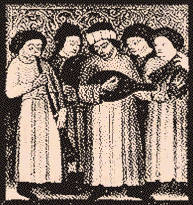Medieval music
The medieval part song developed from plainsong in the church and folk song in the towns and villages. Folk singers have always tended to decorate and to harmonize their songs; in the plainsong chants of the church, the same impulse led to the development of counterpoint (two or more melodies sung simultaneously).
In "The Agincourt Carol," counterpoint begins to create a sense of more modern harmonic writing. (Click on the link to hear it; the word "Carol" is here used in something much nearer to its original meaning, "dance.") The song was written to celebrate the remarkable victory of Henry V at the battle of Agincourt.
While there are many "open" intervals, so that the harmony sounds rather sparse, there are two parts sung together throughout. In the verses the upper part is taken by a tenor; in the chorus a recorder is added. (Click here to listen.*)
Footnotes
-
A song of victory
The music...
Deo gracias Anglia, redde pro victoria.
[Return thanks unto God, O England, for victory.]
Oure kynge went forth to Normandy
With grace and myght of chivalry
Ther God for hymn wrought mervlusly,
Wherfore Englonde may call and cry
Deo gracias. [God be praised.]
He sette a sege [siege] for sothe to say
To Harflu town with ryal [royal] array;
That town he wan and made a fray
That Fraunce shall rewe [rue] tyl domesday.
Deo gracias.
Almythy God he kepe owr kynge
His peple and his welwyllynge
And give hem grace without endyng.
Than we may calle and safely synge
Deo gracias.
